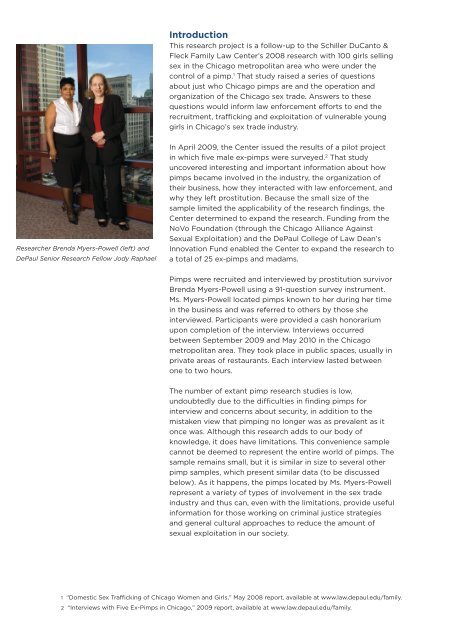From Victims to Victimizers: - DePaul in the News - DePaul University
From Victims to Victimizers: - DePaul in the News - DePaul University
From Victims to Victimizers: - DePaul in the News - DePaul University
Create successful ePaper yourself
Turn your PDF publications into a flip-book with our unique Google optimized e-Paper software.
Researcher Brenda Myers-Powell (left) and<br />
<strong>DePaul</strong> Senior Research Fellow Jody Raphael<br />
Introduction<br />
This research project is a follow-up <strong>to</strong> <strong>the</strong> Schiller DuCan<strong>to</strong> &<br />
Fleck Family Law Center’s 2008 research with 100 girls sell<strong>in</strong>g<br />
sex <strong>in</strong> <strong>the</strong> Chicago metropolitan area who were under <strong>the</strong><br />
control of a pimp. 1 That study raised a series of questions<br />
about just who Chicago pimps are and <strong>the</strong> operation and<br />
organization of <strong>the</strong> Chicago sex trade. Answers <strong>to</strong> <strong>the</strong>se<br />
questions would <strong>in</strong>form law enforcement efforts <strong>to</strong> end <strong>the</strong><br />
recruitment, traffick<strong>in</strong>g and exploitation of vulnerable young<br />
girls <strong>in</strong> Chicago’s sex trade <strong>in</strong>dustry.<br />
In April 2009, <strong>the</strong> Center issued <strong>the</strong> results of a pilot project<br />
<strong>in</strong> which five male ex-pimps were surveyed. 2 That study<br />
uncovered <strong>in</strong>terest<strong>in</strong>g and important <strong>in</strong>formation about how<br />
pimps became <strong>in</strong>volved <strong>in</strong> <strong>the</strong> <strong>in</strong>dustry, <strong>the</strong> organization of<br />
<strong>the</strong>ir bus<strong>in</strong>ess, how <strong>the</strong>y <strong>in</strong>teracted with law enforcement, and<br />
why <strong>the</strong>y left prostitution. Because <strong>the</strong> small size of <strong>the</strong><br />
sample limited <strong>the</strong> applicability of <strong>the</strong> research f<strong>in</strong>d<strong>in</strong>gs, <strong>the</strong><br />
Center determ<strong>in</strong>ed <strong>to</strong> expand <strong>the</strong> research. Fund<strong>in</strong>g from <strong>the</strong><br />
NoVo Foundation (through <strong>the</strong> Chicago Alliance Aga<strong>in</strong>st<br />
Sexual Exploitation) and <strong>the</strong> <strong>DePaul</strong> College of Law Dean’s<br />
Innovation Fund enabled <strong>the</strong> Center <strong>to</strong> expand <strong>the</strong> research <strong>to</strong><br />
a <strong>to</strong>tal of 25 ex-pimps and madams.<br />
Pimps were recruited and <strong>in</strong>terviewed by prostitution survivor<br />
Brenda Myers-Powell us<strong>in</strong>g a 91-question survey <strong>in</strong>strument.<br />
Ms. Myers-Powell located pimps known <strong>to</strong> her dur<strong>in</strong>g her time<br />
<strong>in</strong> <strong>the</strong> bus<strong>in</strong>ess and was referred <strong>to</strong> o<strong>the</strong>rs by those she<br />
<strong>in</strong>terviewed. Participants were provided a cash honorarium<br />
upon completion of <strong>the</strong> <strong>in</strong>terview. Interviews occurred<br />
between September 2009 and May 2010 <strong>in</strong> <strong>the</strong> Chicago<br />
metropolitan area. They <strong>to</strong>ok place <strong>in</strong> public spaces, usually <strong>in</strong><br />
private areas of restaurants. Each <strong>in</strong>terview lasted between<br />
one <strong>to</strong> two hours.<br />
The number of extant pimp research studies is low,<br />
undoubtedly due <strong>to</strong> <strong>the</strong> difficulties <strong>in</strong> f<strong>in</strong>d<strong>in</strong>g pimps for<br />
<strong>in</strong>terview and concerns about security, <strong>in</strong> addition <strong>to</strong> <strong>the</strong><br />
mistaken view that pimp<strong>in</strong>g no longer was as prevalent as it<br />
once was. Although this research adds <strong>to</strong> our body of<br />
knowledge, it does have limitations. This convenience sample<br />
cannot be deemed <strong>to</strong> represent <strong>the</strong> entire world of pimps. The<br />
sample rema<strong>in</strong>s small, but it is similar <strong>in</strong> size <strong>to</strong> several o<strong>the</strong>r<br />
pimp samples, which present similar data (<strong>to</strong> be discussed<br />
below). As it happens, <strong>the</strong> pimps located by Ms. Myers-Powell<br />
represent a variety of types of <strong>in</strong>volvement <strong>in</strong> <strong>the</strong> sex trade<br />
<strong>in</strong>dustry and thus can, even with <strong>the</strong> limitations, provide useful<br />
<strong>in</strong>formation for those work<strong>in</strong>g on crim<strong>in</strong>al justice strategies<br />
and general cultural approaches <strong>to</strong> reduce <strong>the</strong> amount of<br />
sexual exploitation <strong>in</strong> our society.<br />
1 “Domestic Sex Traffick<strong>in</strong>g of Chicago Women and Girls,” May 2008 report, available at www.law.depaul.edu/family.<br />
2 “Interviews with Five Ex-Pimps <strong>in</strong> Chicago,” 2009 report, available at www.law.depaul.edu/family.


